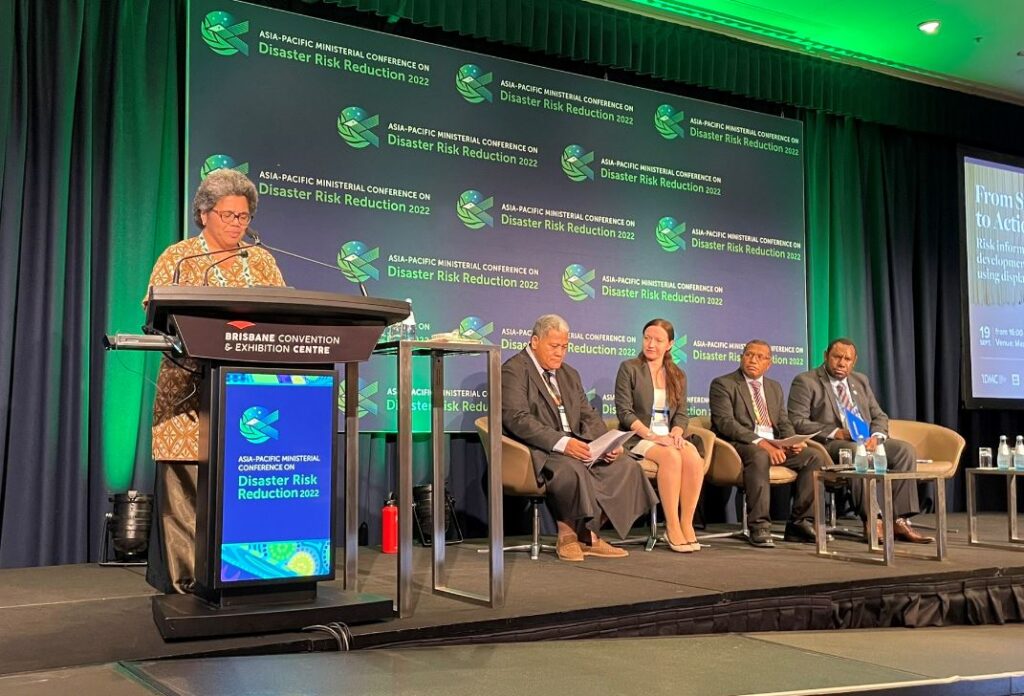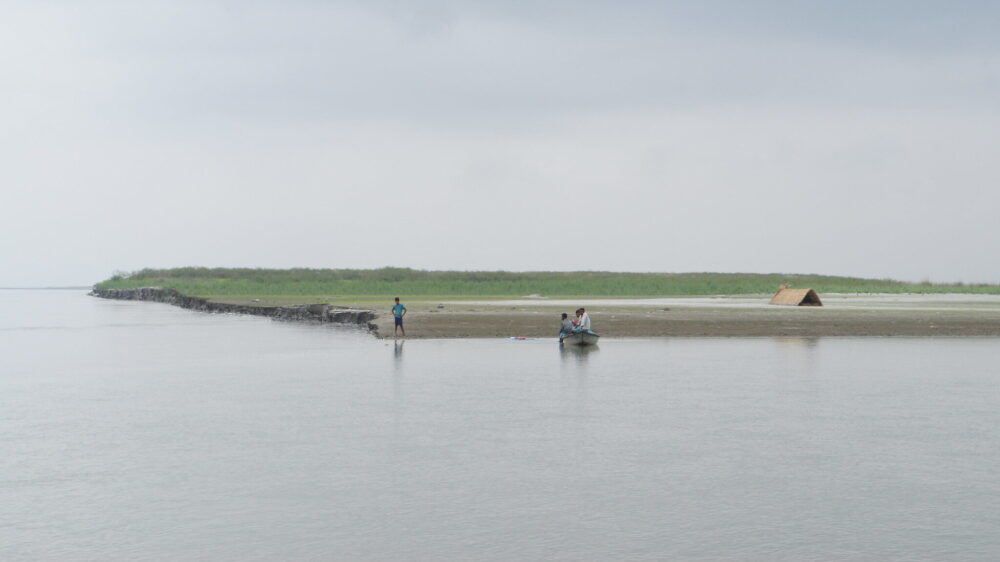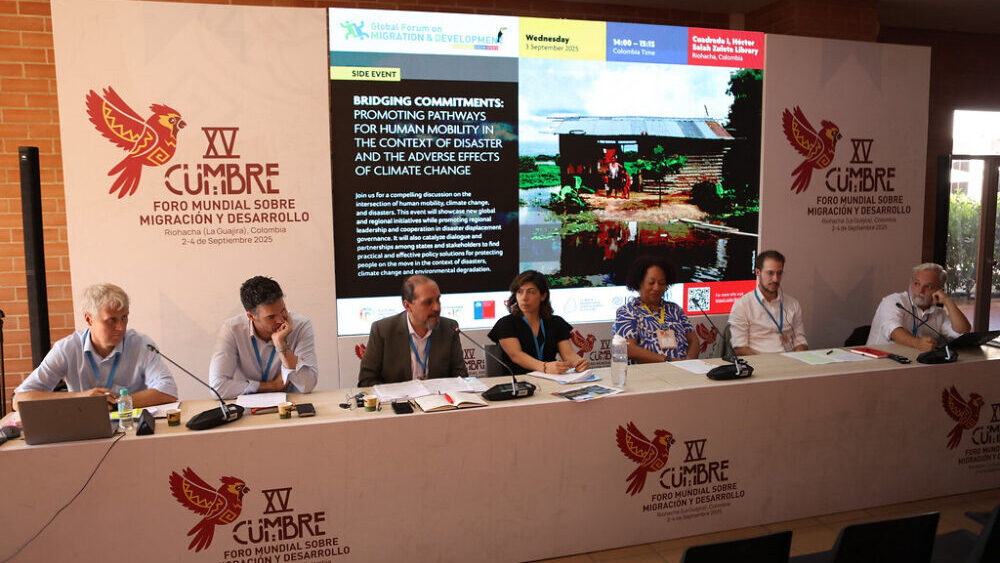Reporting Back | The 2022 Asia-Pacific Ministerial Conference on Disaster Risk Reduction

This article was produced based on reporting material from the Raoul Wallenberg Institute (RWI) and the Pacific Response to Disaster Displacement (PRDD) project.
The topic of displacement in the context of disasters and the adverse effects of climate change was prominent throughout APMCDRR, taking place in Brisbane, Australia, from 19-22 September 2022 under the overarching theme “From Crisis to Resilience: Transforming the Asia-Pacific Region’s future through disaster risk reduction”. The meeting had initially been planned for 2020 and was pushed back to 2022 to be able to take place with a physical component. Select parts of the programme were also available to virtual delegates.
There was notably one spotlight session and one partner event on the agenda that focused on disaster displacement in the Asia Pacific region:
Spotlight Session 8: A human rights-based approach to disaster displacement
On 22 September 2022, RWI Senior Researcher, Matthew Scott, moderated the spotlight event on “A human rights-based approach to disaster displacement”.
The discussion featured all female prominent speakers from various backgrounds, namely: Christelle Cazabat, Internal Displacement Monitoring Centre, Cecilia Jimenez Damary, UN Special Rapporteur on the human rights of internally displaced persons, Tasneem Siddiqui, University of Dhaka and RMMRU Bangladesh, and Esline Garaebiti, Ministry of Climate Change, Vanuatu.

From left to the right position: Esline Garaebiti, Matthew Scott, Tasneem Siddiqui, Cecilia Jimenez Damary, Christelle Cazabat | © Raoul Wallenberg Institute
An average of 25 million people are displaced every year due to the threats and impacts of geophysical and hydrometeorological hazard events. Notably, Asia and the Pacific accounted for more than 80% of all documented disaster displacement between 2008 and 2019. In the Asia and the Pacific region, slow-onset disasters, including droughts driven by climate change, are key drivers for displacement. Effectively averting, minimizing and addressing the risk associated with disaster displacement requires a holistic approach with cross-sectoral partnerships that prioritize the rights and needs of displaced people and affected communities.
This spotlight session focused on practical, human rights-based approaches to both slow and sudden-onset disaster-related displacement. This included assessing potential displacement, preventing and preparing to protect people during evacuation and displacement in a way that minimizes the risks they face, and supporting long-term solutions to displacement.
The event highlighted the importance of a coherent approach to disaster displacement that integrates disaster risk reduction with human rights, humanitarian assistance, sustainable development, climate change adaptation, and human mobility planning. It demonstrated how a human rights-based approach to disaster displacement can help ‘connect the dots’ across sectors, stakeholders, and governance levels in order to leave no one behind; and showcased examples of effective risk governance approaches that reduce risks associated with disaster displacement, improve the protection of displaced people and support resilience of communities, including host communities.
The session concluded with a call on governments to review relevant legal and policy frameworks relating to disaster risk reduction, climate change adaptation, planned relocation, emergency management, and sustainable development in order to better integrate measures to avert, minimize, address, and support durable solutions to disaster displacement, in line with human rights-based approaches; as well as to include provisions to address disaster displacement in local, national and regional DRR strategies to strengthen the resilience and adaptive capacity of people at risk of displacement or living in displacement and in need of rights-based, durable, risk-informed solutions.
Partner event: From science to action: Risk informing development in the Pacific using displacement data
The partner event “From Science to Action: Risk informing development in the Pacific using displacement data” that took place on 19 September 2022 was organized by the Pacific Response to Disaster Displacement (PRDD) Project, an EU funded initiative implemented by the Internal Displacement Monitoring Centre in partnership with the Pacific Community (SPC), the Platform on Disaster Displacement and the International Organization for Migration (IOM), supported by the IFRC and the American Red Cross.
The event was moderated by Ms. Litea Biukoto, Team Leader Community Risk Reduction for the Geoscience, Energy and Maritime Division of SPC. The session drew attention to the fact that the Pacific as a region suffers the consequences of climate change and disaster displacement like no other region and brought together experts on the situation of disaster displacement in the Pacific Island region, drawing on the extensive work of IDMC and its partners under the PRDD project. National and local government, and regional intergovernmental agency perspectives from the Pacific shared their ongoing efforts to consider evidence generated under the project, into national, subnational and regional government response to better avert, prevent and respond to disaster displacement.

Dr. Christelle Cazabat in her keynote presentation, gave an overview of the situation of disaster displacement in the Pacific now and in the future based on key disaster displacement statistics from the Pacific generated through the project. She also highlighted recent findings from the Asia Pacific Report launched earlier that day. One of them was that “nearly 80% of all disaster displacements worldwide took place in the Asia-Pacific region the past 11 years. Displacement has a severe impact on people’s lives especially when they do not find rapid and durable solutions”. After the scene was thus set, Mr. Mafua Maka, director of the National Emergency Management Office of Tonga (NEMO), Mr. Leith Veremaito, Director of the Vanuatu Department of Local Authorities under the Ministry of Internal Affairs, and Mr. Solomon Kantha, Chief of the IOM Mission in Fiji, shared their experiences and perspectives on the use and application of disaster displacement risk information and some of its challenges in the Pacific island region. Mr. Jonathan Tafiariki, Director of Solomon Islands National Disaster Management Office provided closing remarks.
The Co-Chairs’ Statement refers to displacement several times. It states, in paragraph 15, that “disasters may trigger instability and displacement”, and, in paragraph 17, that “onward displacement” needs to be mitigated. It goes further to call on governments “to review legal, policy, strategic frameworks and plans to better integrate measures that avert, minimize and address disaster displacement and support durable solutions”.
Cover photo: © UNDRR
Last photo: © Pacific Community (SPC)
Read the Platform on Disaster Displacement Policy Brief and Key Messages for GP22

More Words into Action Intro Videos on PDD’s YouTube channel




